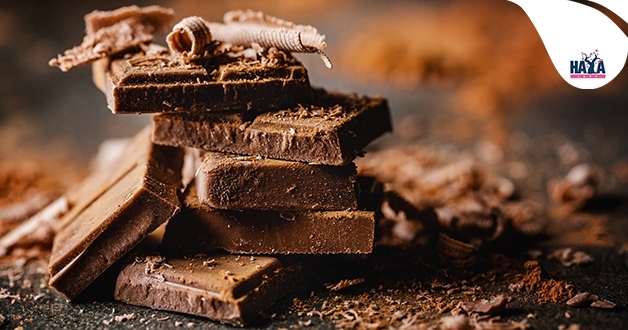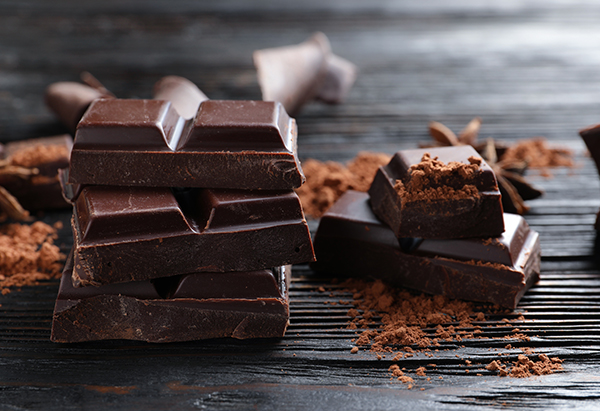
The light side of the dark chocolate
0
1914
Chocolate, which is considered to be the most exquisite culinary art of Belgium and Switzerland, is also on our table recently. Enriching our cuisine with these once exotic foods takes place after the 15th century, ie. after the conquistadors' conquest began.
A little history
For our acquaintance with chocolate, the main credit goes to General Cortez, who, in his meeting with the Aztecs, discovered not only their capital, more than a million inhabitants, which was exotic to Europeans, but was also surprised to find that the treasures of the then ruler Montezuma were filled with cocoa beans.
The precious metals were used by the ancient South Americans for decoration, and their main unit of exchange was cocoa beans. It was also used for food and medicine. Cocoa is chocolate in its most basic form. From the seeds of the cocoa tree, the ancients prepared a bitter drink that "gives endurance and overcomes fatigue; just one glass of this precious drink allows one to go all day without food. "

The Aztecs are also considered to be the inventors of the blender they used to prepare the drink in question. 1590 is the year in which farmers in West Africa plant the first cultivated cocoa trees outside South America.
At first, cocoa did not gain much popularity in Europe because of its bitter taste, but soon Europeans began to mix it with cane sugar to improve its taste, and little by little cocoa conquered the old continent, becoming a favorite drink of wealthier Europeans and Specialty establishments were offered in many places offering drinks.
Much later, in the nineteenth century, the Netherlands patented a process for the production of a new type of low-fat cocoa powder, which provided a cheaper and, consequently, much larger production.
This method involved a hydraulic press that separated the cocoa butter and the residue was pulverized into powder. Potassium or sodium carbonate was added to this powder to obtain a better solubility of the final product. This invention has made it possible to produce a cheap cocoa powder that is readily available to a large population.
The invention of chocolate as we know it today is due to the Swiss chemist Henry Nestle, who is finding a way to make milk powder. With it begins the story of so loved by all, but robbed of nutritional and medicinal values milk chocolate. With our current knowledge, we already know that refined sugar reduces the nutritional and medicinal value of cocoa.
There's something in the chocolate ...
Here is the good news for all chocolate lovers (recall - chocolate means raw cocoa): not only does it not damage your figure, but it is also one of the best foods for you. Cocoa is one of the best sources of magnesium, chromium, zinc, and vitamin C.
It is the plant with the highest iron content. The flavonoids in cocoa are almost identical to those of green tea. It also contains phenylethylamine, anandamide, tryptophan, serotonin, theobromine.
Experiments have shown that cocoa is a food that has almost no effect on blood sugar.
What does this mean?
.jpg)
This means that chocolate (cocoa) is a great food for the cardiovascular and digestive systems, helps maintain oral health, fights iron deficiency anemia, reduces insulin resistance, helps with mood disorders, improves mood and overall mood it works hard to make us feel good.
Theobromine Vs.
read more
It is a common misconception that cocoa contains caffeine, while the truth is that chocolate contains the alkaloid theobromine, which, although of a very similar structure, has a different effect on the human body. Unlike caffeine, the action of theobromine is much softer, lasts longer in time (almost half of it is in the bloodstream up to 6-10 hours after ingestion), improves mood, stimulates the cardiovascular system and muscles. its effect on the CNS is negligible compared to that of caffeine, stimulates kidney function (but is not a strong diuretic like coffee), does not cause addiction and cases of allergy are extremely rare.
What products to look for?
- To date, much of the cocoa production for Europe has been exported to Africa, and in particular to Ghana and the Ivory Coast. Like any high-yield crop, cocoa is subject to gene modification and treatment for greater yields. If you want to reduce the likelihood that you might come across a similar product, you should check the origin of what you buy and research the conscientious manufacturers.
- Look for raw cocoa.
- The most primary form of chocolate, naturally, is raw, fermented and dried cocoa beans, which you can eat whole or grind. Keep in mind that as much as you grind them, you will not get any fine dust as the oil is still present in the grain. Crushed cocoa beans are also a good option.
- Raw cocoa powder and cocoa paste (cocoa mass), which is the ground and liquefied cocoa before extracting the fat, are also suitable options. Here again, it is advisable to look for cold processed products if you want to enjoy all the benefits of chocolate.
Why do some products say cacao and others say cocoa?
Although they are translated in the same way and should refer to the same product, there are some differences between the two concepts.
Cacao is the name of the plant from which chocolate beans are obtained. After harvesting, these grains (which are essentially seeds) are fermented and dried. Subsequently, they are crushed, milled, separated from the fat and displayed in the shops in the form of the products mentioned in the front of the material. powder or other impurities. When the package says it is natural or unsweetened cocoa, it is similar to the product above, but their difference is usually in the processing temperature, which significantly reduces the health benefits of chocolate.
You can distinguish this product by its specific dark brown color, unlike raw cocoa, which is much lighter.
The truths and myths about chocolate (cocoa):
- Studies show that the combined consumption of raw cocoa with dairy products dramatically reduces the absorption of antioxidants in it.
- "Chocolate spoils the teeth" is a widespread myth - what spoils the teeth is the refined sugar that is added to the chocolate. Cocoa beans protect the oral cavity from developing caries.
- Although many people claim to be allergic to chocolate, it rarely causes such reactions. What people are allergic to is milk or sugar, which are added to chocolate products. Studies show that only one in every 500 of those who consider themselves allergic give positive tests.


